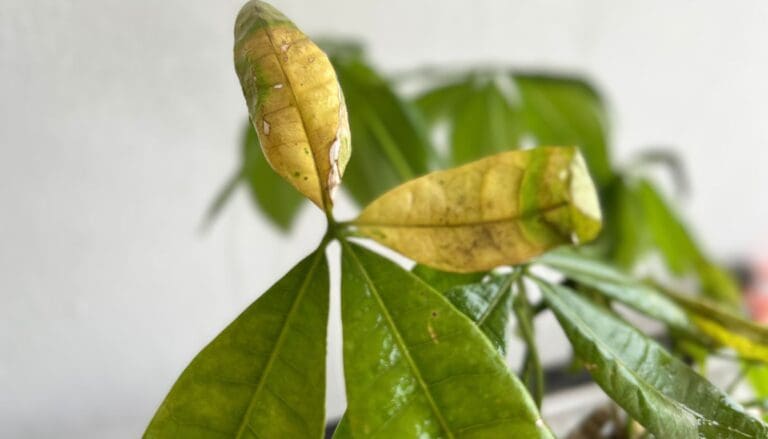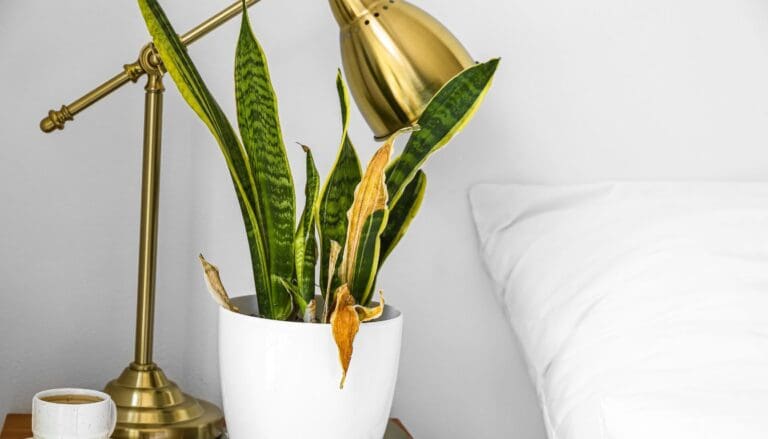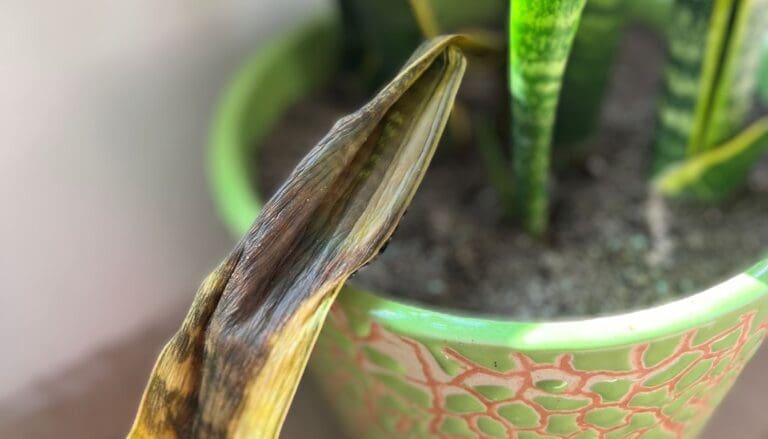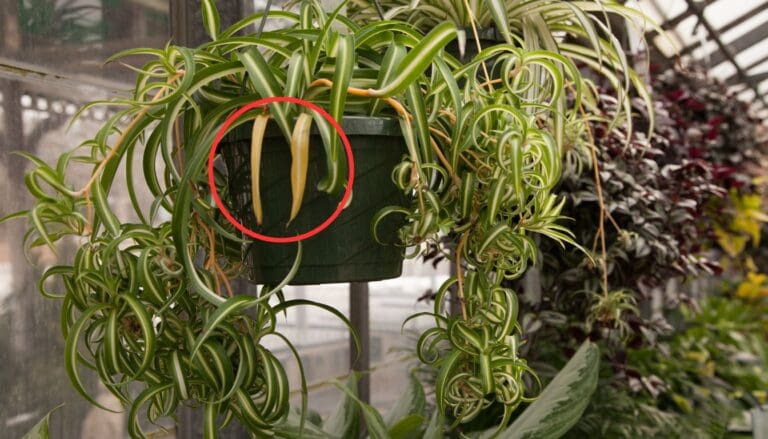Leggy Rubber Plant? 3 Causes & How To Make It Bushy!
Is your Rubber plant growing tall and skinny? This condition is called leggy growth, and Rubber plants growing leggy look unattractive and sparse. Today, we will learn everything about a leggy Rubber plant.
The Rubber plant becomes leggy due to three main factors: not enough sunlight, overfeeding, and insufficient pruning. To fix the legginess, adjust the light conditions, correct fertilizing schedules, and prune regularly in the growing seasons.
Don’t lose hope if your Rubber plants are turning leggy. In this article, we will explore the reasons behind a leggy Rubber plant and share simple steps to fix it and make it bushy and healthy.

Please note: Simplify Plants is reader-supported. As an Amazon Associate, I earn from qualifying purchases made by our readers with no extra cost added to you all! Some links in the post are affiliate links and I get a commission from purchases made through links in the post.
Understanding why your Rubber Plant is Leggy
Rubber plants can reach a height of 8-10 feet indoors.
But tall and thin stems with fewer leaves indicate a leggy growth.
Leggy growth occurs when some requirements are not taken care of correctly.
The plant will look very weak, and the leaf growth will be much less than before.
Over time, it can droop and fall over.
As a houseplant enthusiast, you don’t want that.
Understanding the causes of leggy growth and taking the right steps can lead to a healthier, bushier plant.
Let’s look at the reasons that make the Rubber plant leggy.
There are not many reasons that can make your plant leggy.
So, troubleshooting the problem is easy.
Three reasons can make your lovely Rubber plant leggy and unappealing:
1. Insufficient or low light levels can make your rubber plant leggy
The Rubber plants prefer bright indirect sunlight to perform at their best.
When the plant does not receive enough light throughout the day, the stems will grow taller towards the light source and become leggy.
Due to the legginess, the Rubber plant won’t sustain the weight of the leaves.
It will frequently bend down close to the soil.
Incorrect light orientation also promotes leggy growth.
When one side doesn’t receive light, while the other side does, the former side will have a leggy growth while trying to reach the light.
To learn more, check out our article on lighting requirements of rubber plants.
2. Over-fertilization or excessively nutrient-rich soil can make your rubber plant leggy

As with most things in life, anything excessive can harm the plants, and Rubber plants are no exception.
Rubber plants benefit from fertilization, but overfertilization makes your Rubber plant leggy.
Fertilization promotes fast and healthy growth.
However, excessive nutrients boost plant growth so much that only the stems and branches grow tall and thin, but the leaves don’t.
The same happens when you use overly rich soil with too many nutrients, especially nitrogen levels.
The primary reason for a leggy Rubber plant is high nitrogen levels in the fertilizer or the soil.
High nitrogen levels trigger rapid growth, resulting in excessively long stems.
3. Irregular pruning can make your rubber plant leggy
Rubber plants can grow quite big and tall. They are moderate to fast growers.
You must prune them regularly to maintain their shape as houseplants and promote leaf growth.
Without regular pruning, your Rubber plant will grow tall and leggy.
Also, the plant keeps wasting energy behind the damaged leaves instead of the new leaf growth.
Unfortunately, you won’t witness any new leaf growth for this.
Overall, it makes the plant look very unattractive and dull.
Signs of a leggy Rubber plant
Before you fix a Rubber plant, learn the signs of legginess to prevent misdiagnosis.
Here are some potential signs a Rubber plant shows when it is growing leggy:
- Tall and thin plant: A tall and thin plant is one of the most apparent reasons for a leggy Rubber plant. The stems will be bare with very few leaves.
- Leaves far apart: Leaves grow very far apart because they try to reach the sunlight.
- Pale green or yellow leaves: Lack of sunlight affects chlorophyll, resulting in yellowing. Salt buildup from over-fertilization burns the roots and affects the nutrient and moisture uptake, triggering yellowing.
- Drooping Rubber plant: A leggy Rubber plant will droop and fall off because the stems are tall and thin and can’t hold the weight of the leaves.
- Unhealthy appearance: A leggy Rubber plant with very few leaves looks unhealthy.
4 Easy steps to fix a leggy Rubber plant
Now that you know the causes and signs of a leggy Rubber plant, it is time to learn how you can resolve the issues causing a leggy Rubber plant and restore the plant’s shape and vigor.
1. Light requirements for Rubber plants

Relocate your Rubber plant to a location that does not receive direct sunlight throughout the day.
Even low lights are better, but make sure they are not in the dark.
A west or east-facing window will work in summer.
If you have a south-facing window, use Venetian blinds or sheer curtains to filter the sunlight.
Do the opposite in winter.
You can use Grow lights, like fluorescent lights or LED lights, too, if you don’t have suitable places that give proper light.
Maintain 6-12 inches of distance between the lights and the plant.
Another thing to consider is the duration.
Improper durations of light can cause weak stems and less amount of leaves.
I recommend to provide at least 12-14 hours of light and 10-12 hours of darkness.
By adjusting the light intensity and duration, your leggy Rubber plant will restore its vigor and produce new leaves.
Make sure all the sides are getting enough sunlight.
After the shift, check your plant’s behavior for a few weeks.
Once your plant becomes bushy and stops growing leggy, consider the issue resolved.
2. Fertilizing the Rubber plants correctly
If you need a fertilizer schedule, I advise applying it once every 2-3 weeks or monthly throughout the spring and summer.
If you suspect you have applied more dosage, flush off the soil or skip 1-2 applications.
This will reduce the chances of overfeeding.
Avoid using high-nitrogen fertilizers.
Excessive nitrogen also makes your plant extremely thin and leggy.
Always go for balanced fertilizers for the Rubber plants. Try these 2 options:
- Espoma Organic 8 Ounce Concentrated Indoor Plant Food. It has an NPK value of 2-2-2.
- Jack’s Classic Water Soluble All Purpose Fertilizer.
For the correct dosage and overfertilization prevention, you must follow the instructions given on the package labels.
Always dilute the fertilizer with water to make the dosage to half the recommended strength.
It not only reduces leggy growth but also fertilizer burns.
Observe your plant growing after adjusting the fertilization.
If it stops growing leggy, your problem is solved.
As for the leggy part, you can either keep it or trim it off to shape your plant. Keep reading to learn how to fix and shape the legginess.
Reduce the frequency of fertilization and cease it during the fall and winter.
3. Pruning the Rubber plants correctly to fix the legginess

Prune the Rubber plants every year once during their growing season, i.e., spring and summer.
After pruning, the plant needs some time to heal.
Fast recovery is possible when the plant grows actively.
Don’t prune during the winter.
Since it stays dormant, it won’t be able to heal itself and suffer from stress and other issues.
I was once asked by one of my friends about this.
She was a beginner and overfed her plant, which resulted in a leggy plant.
I helped her with the fertilization schedules and fixing overfeeding, but she needed help in removing the legginess.
Here’s what I suggested to her about pruning the leggy Rubber plant.
I also follow the same process:
- Begin with pruning the dead and damaged leaves. It will stop the plant from wasting energy behind these leaves and encourage new growth.
- Next, consider horizontal trimming of the back of the lower thin branches growing irregularly and damaging the shape.
- Cut these leggy stems around 4-6 inches.
- When making the Rubber plant from leggy to giving it the desired shape, prune the top leaves before the leaf nodes.
- To prevent excessive dense, trim a few branches and leaves from the center of the plant.
- Trim the top off when the plant exceeds the maximum height. Make the incision at the angle above the leaf node where the leaves are connected to the stem.
After pruning, water your plant to reduce its stress and ensure it receives bright, indirect sunlight.
It will discourage leggy growth, encourage new growth, and make it bushy.
Repeat the procedure whenever your Rubber plant seems to be growing leggy.
4. Repot the Rubber plants
An overly rich soil is also responsible for a leggy Rubber plant.
In such a case, you must repot your plant with new soil.
If there is no other issue, like infestation or root-bound, you can reuse the same one.
The goal is to rejuvenate the soil.
Use a high-quality potting mix that is good in drainage and retention and contains adequate nutrients.
Please make it less rich. You can follow our soil article for the Rubber plants to learn the soil mixes.
Take the plant out from the old pot carefully and discard the old potting soil.
If it is already time for repotting, choose a 1-2 inch bigger pot than the old one. Otherwise, use the old pot only.
Fill it half with soil, plant your Rubber plant at the center, and add more soil to cover the roots and the surroundings of the plant.
Water it well and let it have bright indirect sunlight.
You might notice some browning or yellowing initially due to repotting stress.
If the problem has been with the soil, your plant will recover and stop being leggy further.
How to make a rubber plant bushy?

Pruning encourages bushy growth and prevents legginess.
But pruning alone can’t do it. You must provide other care tips to stop the stems from growing tall and thin.
Here’s what you can do:
- Find a location that receives bright, indirect sunlight throughout the day. Use Venetian blinds or sheer curtains if the intensity feels high.
- You need to turn or rotate your plant regularly so that all sides receive sunlight equally.
- Don’t over-fertilize. If you are unaware, use less amounts less frequently. Fertilize only once a month with a balanced liquid fertilizer. The dosage should be half the recommended strength.
- Water the Rubber plant before and after fertilization. It reduces fertilizer burns and spreads nutrients evenly.
- Regularly prune your plant. It can stop thin and leggy stems and encourage more leaves and branches. Follow the pruning tips I have shared.
- Keep caring for your plant. Maintain consistent watering, use well-drained soil, provide average humidity around 50-60%, and temperature should be warm within 60-80°F.
- Repot your Rubber plant once a year during the growing season. It gives the plant space to grow. In this case, your plant will get rid of overly rich or overfed soil.
The correct way to prune your rubber plant to prevent legginess

I have already discussed how to prune in short earlier.
Here I’ll share in details.
Besides, the previous pruning was to fix the leggy stems, and this one is to be followed during your regular pruning practice to prevent legginess and promote bushy growth.
While pruning does promote bushy growth, incorrect techniques can harm your plant.
Many people often inquire about the proper way to prune Rubber plants.
So, here’s what I do:
- First, remember that pruning should be done during the spring and summer when the plant is actively growing. Since it will get hurt through pruning, the active growth season will encourage fast recovery.
- Wear gloves before pruning because the sap can mess up your hand while working.
- For a bushy growth, cut above the nodes. These are the areas where small stem branches appear from the side of the large central stem.
- Cut the top of the Rubber plants when they reach a desired height. It will encourage horizontal growth, create a round shape, and make it fuller.
- Don’t over-prune. Leave 2-3 leaves on every branch, and don’t remove more than 5-6 living branches in one pruning session.
- Prune the branches often during the growing season for a bushy growth. You will notice at least 1-2 new branches in the pruned area.
If you have cut healthy living pieces, you can use them to propagate and receive more Rubber plants.
For a bushy growth, I also suggest allowing the Rubber plant to branch out. For this, you should try some tailored pruning techniques called apical dominance.
Here’s how you can prune to promote branching:
- Remove the top growth on the Rubber plant’s main stem.
- Cut at the top first and remove the stem and leaves as much as you like.
- It will promote branch growth at the lower down on the stem and make it branch out.
One of my readers followed these steps to make the plant bushy.
The results were amazing. Her plant has grown very bushy and healthy.
Provide the basic needs to the Rubber plant to help it recover and grow bushy.
While pruning the Rubber plant, a white sap will emerge from the wounded areas.
It is the latex used for plastic production.
Don’t let this latex touch your skin. It can cause skin irritation.
If it has come in contact with your skin by mistake, immediately wash your hands very well.
Whenever you are pruning, do not trim off more than ⅓rd of the plant in a day. Excessive pruning at once will stress the plant and affect its optimal growth. Pruning can be done throughout the growing season, but not too much at a time.
Note: You don’t have to throw the cuttings or get new cuttings separately for more Rubber plants. Use these pruned pieces to propagate. But these cuttings need to be healthy. Remember that propagating these cuttings is around 4-6 inches long.
Final thoughts
If you have reached the end of the article, you have learned the reasons that make a Rubber plant leggy and how to fix the legginess. Three common reasons that cause legginess are insufficient sunlight, over-fertilization, and lack of pruning.
Letting the Rubber plants have indirect sunlight throughout the day, feeding once a month with a balanced, water-soluble fertilizer, and pruning regularly in the growing season can maintain a good shape, promote a bushy plant, and prevent leggy.
Except for these, care for your plant by maintaining consistently moist soil, using well-drained soil, keeping the temperature within 60-80°F and humidity around 50-60%. After pruning, you can use the cuttings for propagating more Rubber plants. You can propagate in water, soil, or by air layering method.
How much should I prune the leggy Rubber plants?
If your Rubber plant is too tall, consider trimming at least 4-6 inches. Remove only 5-6 branches and leave behind 6-7 leaves in each branch growing in the plant.
What height would be ideal for the indoor Rubber plants?
Indoor plants can grow around 8 to 10 feet. If you have a compact space, 4 feet of height would suffice. If the plant grows leggy from the top, start pruning from the top while maintaining your desired height.
Reference: Rubber plant Wikipedia
Recommended Garden Supplies
| Product Image | Our Recommended Gardening Supplies | Check Offers! |
|---|---|---|
Top Top
Top
Top
Top
Top
Top
Top
Top | rePotme Houseplant and Tropical Classic Potting Soil Mix | Check Offer On Amazon |
 Top
Top
Top
Top
Top
Top
Top
Top | Espoma Organic Indoor Plant Food | Check Offer On Amazon |
 Top
Top
Top
Top
Top
Top
Top
Top | GooingTop LED Grow Light 6000K Full Spectrum Clip Plant Growing Lamp | Check Offer On Amazon |
 Top
Top
Top
Top
Top
Top
Top
Top | Soil Moisture Meter | Check Offer On Amazon |
 Top
Top
Top
Top
Top
Top
Top
Top | Govee Hygrometer Thermometer, Bluetooth Enabled! | Check Offer On Amazon |
 Top
Top | LEVOIT Humidifiers for Large Room(Best For Plants) | Check Offer On Amazon |
 Top
Top
Top
Top
Top
Top
Top
Top | Upgraded DIY Automatic Drip Irrigation Kit, 15 Potted Houseplants Support | Check Offer On Amazon |
 Top
Top
Top
Top
Top
Top
Top
Top | Stainless Steel Heavy Duty Gardening Tool Set | Check Offer On Amazon |
 Top
Top
Top
Top
Top
Top
Top
Top | Bonide Insecticidal Soap | Check Offer On Amazon |
 Top
Top
Top
Top
Top
Top
Top
Top | Bonide 32 oz Spray Neem Oil for Organic Gardening | Check Offer On Amazon |
 Top
Top
Top
Top
Top
Top
Top
Top | Garden Safe Fungicide | Check Offer On Amazon |







I was looking for pictures of trimming and possible propagation of planting the trimmings. I’m a picture person. Thanks.
I am sorry for that, you can check pictures of propagation in our rubber plant propagation guide article.